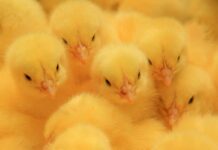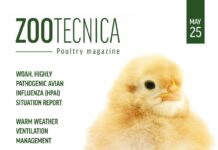
Gene-editing approach transfers beneficial genes between breeds to produce offspring with useful characteristics.
White Leghorn chickens had a naturally occurring change to their genes amended, to restore their black plumage. Sterile male and female chicken eggs have been implanted with reproductive cells from donor birds and the resulting chickens mated together, to produce chicks of the donor breed.
The chicks showed characteristics inherited from their real parents, the donor birds, along with the edited change to their DNA, rather than their surrogate parents.
The outcome, using gene editing, demonstrates an efficient way to introduce beneficial characteristics – such as tolerance for warm climates, or disease resistance – from one chicken breed to another. The application of this technology could bring benefits to the global poultry industry – from large scale commercial operations to smallholder farmers in low- and middle-income countries. Beneficial genes can be transferred from one breed into another via gene editing of embryos, in a single generation. The approach could also help safeguard rare chicken breeds, by storing frozen reproductive cells.
Editing traits
The method to control the reproductive genes carried by both parents – known as Sire Dam Surrogate mating – can ensure that offspring will inherit a desired gene from both parents, and exhibit the characteristic associated with that gene.
A team from the Centre for Tropical Livestock Genetics and Health (CTLGH) and the Roslin Institute, with their commercial partner Cobb-Europe, demonstrated their approach by using sterile male and female chickens, known as empty nest chickens, to transfer feather characteristics between breeds. The team removed reproductive stem cells – early stage cells that later develop into sperm and eggs – from chicken embryos using gene-editing technology, and used the same technology to introduce gene edits into these reproductive cells from another breed.
The altered reproductive cells were then implanted into surrogate parents – the embryos of chicks and cockerels that were bred to be sterile. These surrogates were hatched and mated with one another. The resulting offspring were of the donor breed, and not that of their surrogate parents. They also had the new traits created by gene-editing technology.
Researchers demonstrated their approach by repairing a natural genetic change that causes distinctive white plumage in the White Leghorn breed. The chicks born to the sterile chickens now had a black plumage. Similarly, the team introduced a distinctive curly feather, which is believed to help Western African breeds cope with hot climates, into chicks bred from Light Sussex chickens, a British breed.
The concept could allow the transfer of useful traits among the world’s 1,600 breeds of chicken, and could aid animal productivity and welfare, and help safeguard against changing environmental conditions. Researchers agree that poultry production in low- and middle-income countries could benefit hugely from this research. Key indigenous chicken breeds that are well suited to living in challenging conditions could be preserved using this new technology. The genetics of future generations of indigenous breeds could also be improved through the sharing of beneficial traits, leading to healthier, more productive birds.
The study was published in Nature Communications, and research carried out at the National Avian Research Facility at the Roslin Institute. The work was funded by the Bill & Melinda Gates Foundation and the UK Foreign, Commonwealth and Development Office through CTLGH, as well as UKRI and Innovate UK.
Source: The Roslin Institute

















